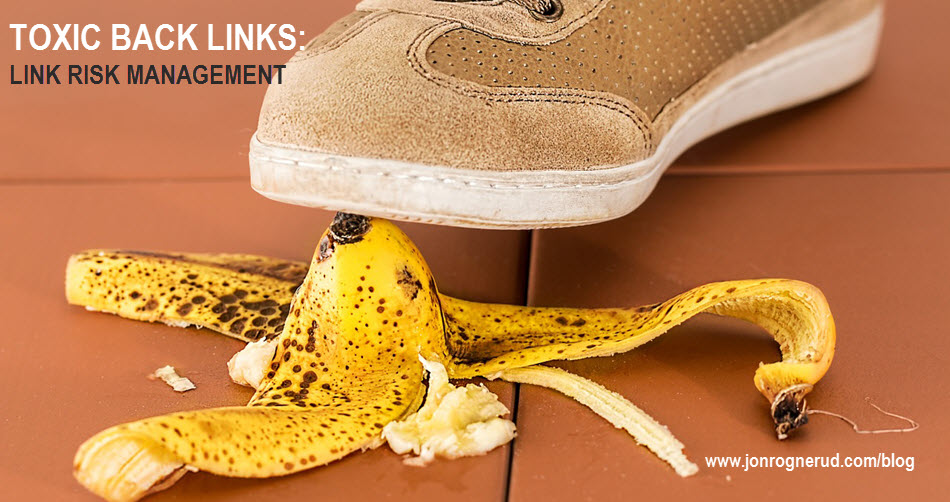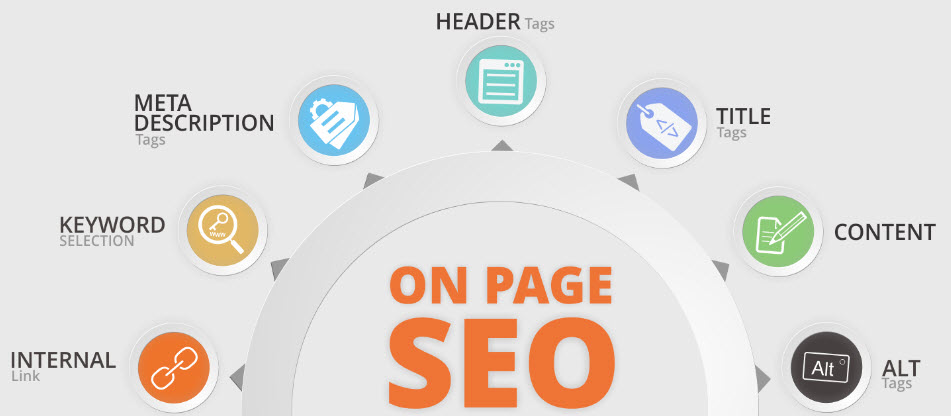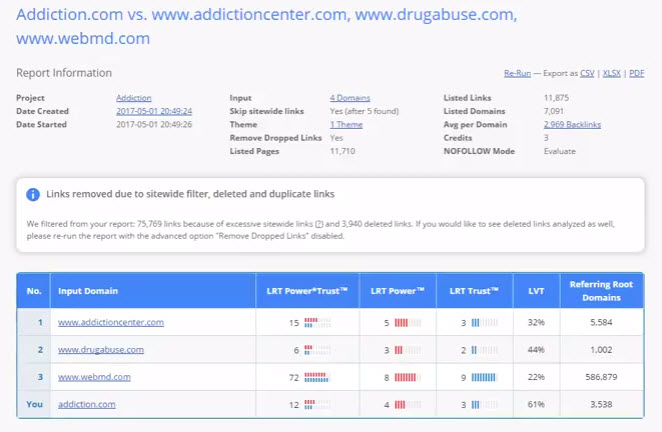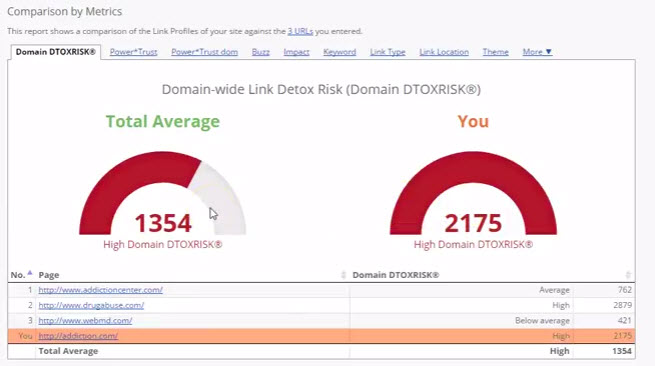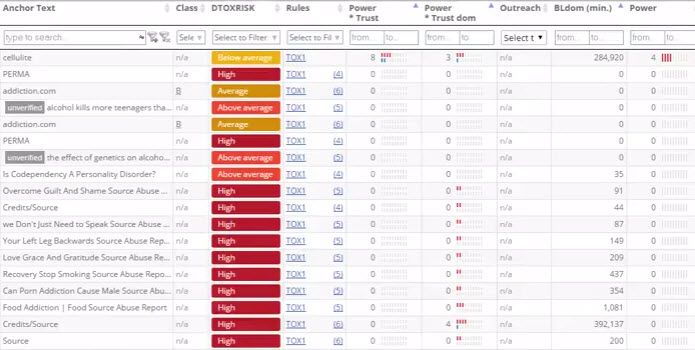Toxic back links in Google: How to find dangerous links that can destroy your SEO efforts (E.g. Penalties, traffic drops, rankings suddenly falling to page 2 and beyond)
My major aim here today is to answer various questions that come up (frequently) regarding Google and toxic back links. Link risk management has become the new normal in your SEO projects.
(This post from the original video below)
What are toxic links, anyway?
Toxic links are referring backlinks that are highly risky to a website’s search engine optimization (SEO) progress (i.e. you’ll struggle with Google organic ranking work). They are not considered natural, and can/will hurt your SEO progress. Plus, any traffic that may come from them, will not be high quality, and therefore not great converting.
Your backlink profiles need to be checked regularly (daily, weekly), dealt with (disavow) to help your website pages rank high, protect your existing listings, and to continually grow upward.
I’m quite sure having a high-ranking website is your ultimate goal as a website owner.
Right?
Search engine scoring changes often
Because of ongoing changes in the Google algorithm and the various updates over the years, and sometimes very frequent updates — whether they’re rather small or not, it does count into what Google wants to do: To serve quality content and user experiences — and primarily ads.
But, we are dealing here in the SEO space, so we want to create an optimal experience for users in organic search results. This is for you, reading this post.
What’s the optimum way to stay ahead with SEO this year?
What’s the best way to conduct SEO projects this year, and into the years ahead? Without getting into specifics too much, you must consider three things … and you’ve heard a couple of these before:
• Content (keywords, topics)
• Links (referring backlinks, incoming links)
• Rankbrain (AI, ML, Deep Learning *See definition below)
We can discuss what comes first, but links drive the web — therefore, you can infer what you’d like.
But of course, content and keywords create interaction, engagement and communication, so that is at the human level.
The introduction of RankBrain allows for machine learning, which sort through search results and tries to learn from them.
Machine learning is here
AI (artificial intelligence), human or machine intelligence rather, machine learning (ML), machine readable context frameworks and learning logic has been developed and used. (Billions of data points can be taken into consideration to process complex patterns of user behavior and engagement. This will help find and display the best, most relevant results at that moment, for short, medium and long-term business value).
Those three count into the core search algorithm, if you will — and are central to the top ranking factors for Google.
Related note: Voice search, mobile adaptive designs and progressive web apps are already here, but we’ll not go into detail in this post. Just keep in mind that voice and mobile is growing fast in adoption and usage.
What is the #1 focus for SEO now – what should I start with?
Now, one of the things that came up during this question was, “Jon, what do I need to do for SEO and, you know, specifically for building out content and links?”
Think of creating engaging content that allows Google to look at behaviors more than just, “Hey, we have a static link here and a keyword on the page.” It’s much more dynamic than that.
Well, it still begs this ultimate question of, “What do I focus on first?” (Note: The ultimate SEO checklist provides more detail and case studies, tools and research)
On-page factors and content are important
All on-page factors will need to be addressed and be compliant to “best practice” and that includes both HTML code and content. Answering questions and providing quality content (See Google Quality Raters Doc) can get you into “featured snippets” which are important, as is PWA, AMP (recommended for news publishers initially) and the upcoming Mobile First Indexing frameworks.
I get questions like: “Hey, I’ve done my title tags right. I’ve done the on-page factors right. I don’t know what else I should be doing. I’ve added rich content. I could keep adding more, more content. I could change and add to my architecture, URLs and navigational structure. I can send links within the body context (internal link building)…not side banners or footers, but valuable, context driven links — you know anchor text within my site.
The most important pages to me is based on not only traffic, but – pages that provide helpful information that leads to a conversion.
But nothing seems to work. Nothing seems to be really pushing the needle forward. What else should I be doing?”
Toxic backlinks fill today’s web eco-space
And quite often, especially with newer people who work on SEO and web ‘mastering’, if you will, having considered external links and the power of those, and more importantly, this idea of toxic links. The truth is that there isn’t going to be any website out there without some level of toxicity, no matter how minimal, because it’s the nature of the web.
However, if you accrue too many within a short period of time and in an unnatural way, and you have a history of this, plus you may have received a manual penalty and not even known about it… You may have received an email message within your Google Search Console… well, that’s bad news.
But, the truth of the matter is, you need to look at everything on your pages, as well as externally, meaning off the page, right?
That’s what we call on-page and off-page analysis and project work. So when you do this, one of the things you need to look at …is the fact that, are you incredibly high in terms of toxic links count? We need to talk about how to clean that up – and so that’s what I wanted to do here today.
Backlinks review – case study
Therefore, I’m going to take a look at a competitive space inside the addiction and drug abuse markets.
WebMD.com, drugabuse.com, addiction.com, addictioncenter.com are listed below as examples. So basically, what I did is, in trying to answer this…
“Is my domain being hurt in Google?”
Well, if you look at your domain and you start looking at your back links essentially, your incoming refer links from referring domains, it’s not necessarily easy to spot that right off the bat, although experienced SEOs can probably or would likely be able to go in and export data from link research tools like Majestic, Moz OSE and Ahrefs, and even within the Google Search Console and into Excel, and manually start perusing that.
Domain and marketplace comparisons will give you additional insight to this market.
Example Moz OSE:
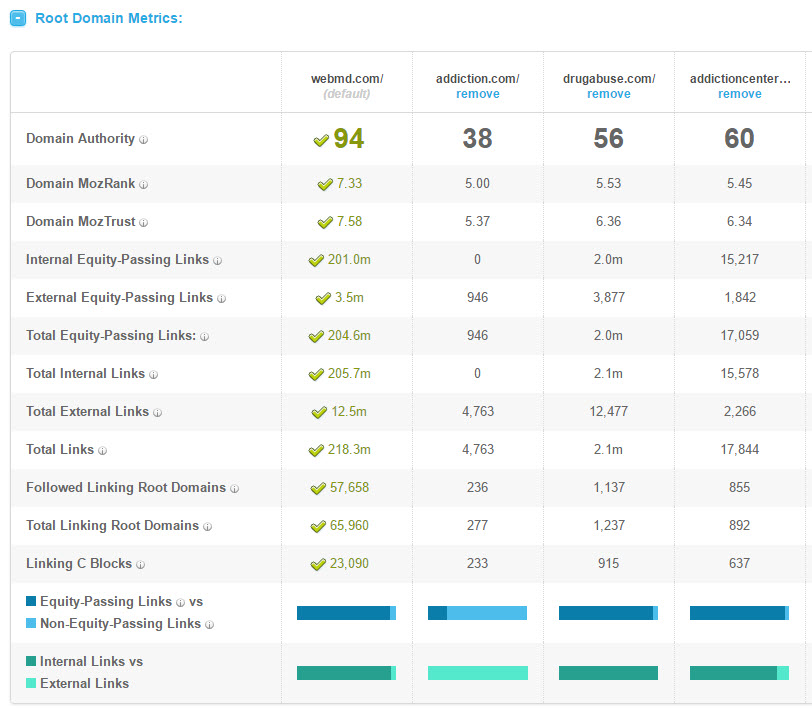
Example Majestic:
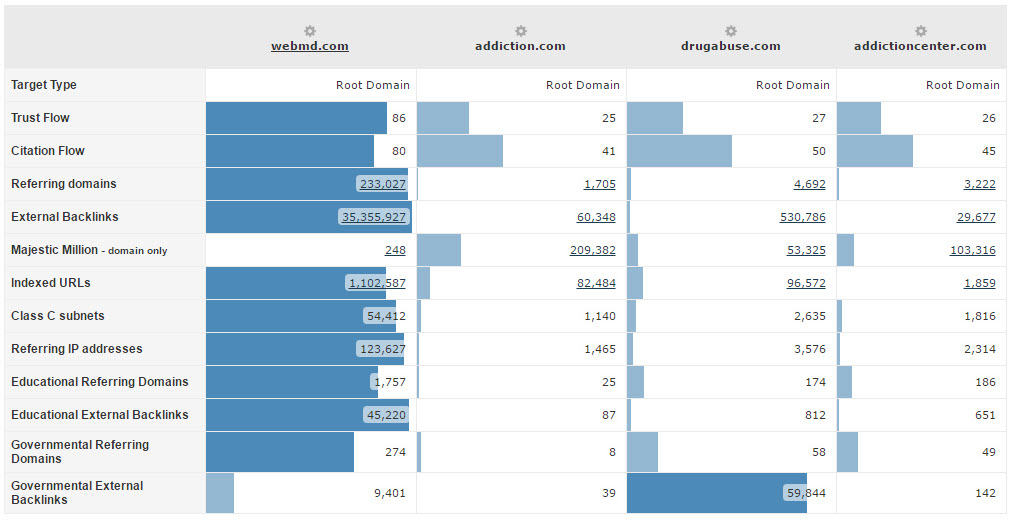 Example Ahrefs:
Example Ahrefs:
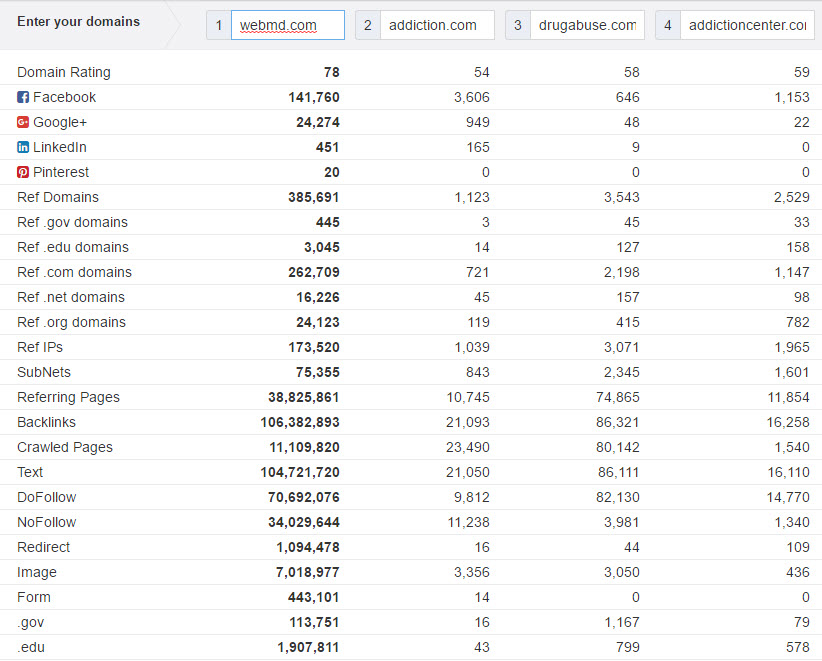
They might surprisingly find out that there appears to be a lot of low, kind of semi risky and perhaps even super risky back links, and if that profile is heavy in terms of the load of those, well, you could put yourself in a risky state.
You would be hampered by all your great on-page work, because you don’t have the quality through the external link profile. I’m sure nobody would like to experience this.
So anyway, just really quick here, as I mentioned with that sort of top level informational rant of sorts. Here, we’re looking at one of the websites that we’re helping with, and looking at the space, because frankly if you just look at the backlinks for your site, there’s going to be a level of toxic links, as I said, or negative links.
That doesn’t matter if it’s not out of balance, but it matters in context of your competitors.
Domain-wide link detox review – toxic links research
And so here, you actually have the ability to look at domain-wide link detox risks, and the way you do that is by inputting the various websites in your space, and this system, which is LRT Link Research Tools, allows you to go in and say, “Great. Got the space here, at least the ones I want to look at right now. Where do I stand compared to the total average in my market?”
So – as an example – if the total average (mean) is around 100 and you’re at 500, I’m sort of extrapolating from this, well, you could be considered a very high outlier and in the high risk category, simply because compared to all the others, they are perhaps average or below average.
Here’s what we see as far as Detox Risk:
WebMD is below average.
Addiction Center is average.
Drug Abuse is high.
Addiction is high.
…which I could probably think about why that is. It may just be the nature of this space, but this gives you a good picture right away to answer this question, “Am I at risk for being penalized somehow and this is possibly a major reason for not getting the traction that I want when pushing my web / SEO work specifically forward?”
Well, then, do a market comparison.
Because each market is different. We’re talking about regions. We’re talking about locally, nationally, globally. We are talking about different keywords, different niches, like markets, right? It’s more like we’re talking about this market here.
So all of these then play into this idea that you need to dissect each market, each competitor that you have in that market, and see where you actually stand versus them, right?
So this is almost double or coming up on double, although there’s, that’s a little short of double, but you get my drift. The idea is that it seems that you have some high level of toxicity here.
Now it goes beyond just a snapshot of a graph. You have to look at the trust signals, the authority signals. You have to look at, of course, if they are truly toxic.
And by toxic, there are many levels within that discussion, which we’ll cover in another post.
But at least it gives you an idea that, okay, perhaps I am pushing the boundaries, and whether that is willfully, meaning you had some black hat and funky link building going on maybe several years ago, that’s now catching up with you, or if it’s somebody in the space that’s trying to push this negative kind of idea towards you. (Although that’s changed a little bit in the discussion, especially since Hummingbird and RankBrain and all these new updates came out).
Bad neighborhoods are dangerous for SEO campaigns
The idea is this:
If you belong to a ‘negative’ / ‘bad website neighborhood’, and you have more of those than you have positives, you’re definitely going to have to work harder on trying to push the needle forward or upward in Google, and in search engines in general.
In truth, if you have traffic that’s coming in from these external domains and they’re not converting, and you’re spending more time trying to get things to be pushed forward and upward in search engines, is that helpful? Of course…it’s not, right?
So you want to be able to always and daily check and monitor your link alerts or your links, and go in and actually check, do I have a highly modified profile that’s changing drastically? We talked about link velocity.
Link velocity and trends data
Link velocity is the idea that we have links that are being acquired or sucked into your domain, for lack of a better description, in a much faster, unnatural way than has previously been the case. Now there are variables that go into that as well, which I won’t discuss here right now, because it’s intended to be a quick video, but really this is to answer this question…
“Am I at risk for, you know, toxic links in Google? Do I need to have them removed, and what do I need to push the needle forward?”
In Conclusion: research, analyze and monitor backlink profiles
So just to summarize then on this whole discussion of Google and toxic links, as we come to a close … is that you need to analyze and continually check it. There is no escaping it. And yes, for large backlink profiles, there will be manual work. The end result is that you send / upload disavow files to Google (and you need to track these as well).
You need to be answering this question, “Am I working hard on content and on-page factors and seeing no traction?” Well, it could be because you have toxic links and that there’s a need to detect that, which again I’ve said you must do, but you cannot just assume that that’s the case alone. You have to clearly go and build links.
In the process of building links and outreach and link reclamation and broken link building, there are many strategies here, which I’m going to give to you in another video. Some of our insider circle members get access to this, but again, this is not a pitch for that.
I just want to let you know that many of these questions that come up are so focused on on-page factors and making sure the title and the meta-tags are done right. But you are forgetting about the external links, and more importantly, the existing profiles that are there now!
Some Great News:
So, I hope this post helped you. I hope you will now act and start thinking about this, and please send any questions over to me. I’ll be happy to answer those as well.
The good news is that I have set aside some time to speak with you.
You can select a time that works for you here.
Have a great day, evening or night!
DEFINITIONS:
AI = Artificial Intelligence, Intelligent machine
ML = Ability to learn without being explicitly programmed
Deep learning = Specific ML technique
Free Download: 51 Link Research Tools
Download my free 51 proven link building and analysis tools here
Further Reading / Resources:
• https://www.kaushik.net/avinash/artificial-intelligence-machine-learning-implications-marketing-analytics/
• https://digitalmarketinginstitute.com/blog/2017-3-20-link-detoxing-what-is-it-and-why-should-you-care
• https://chaosmap.com/backlink-audit-link-analysis-google/
Post from original “Toxic Links In Google” (VIDEO)
